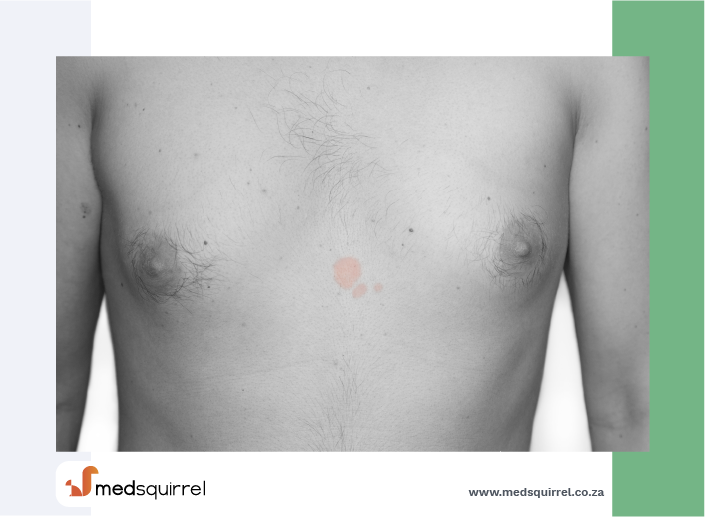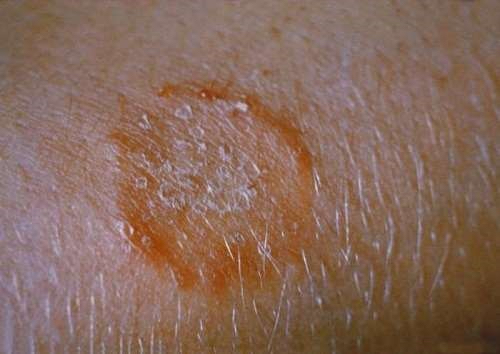Conditions Explained
Disclaimer:
This website is intended to assist with patient education and should not be used as a diagnostic, treatment or prescription service, forum or platform. Always consult your own healthcare practitioner for a more personalised and detailed opinion
Ringworm

We have selected the following expert medical opinion based on its clarity, reliability and accuracy. Credits: Sourced from the website Patient UK, authored by Dr Mary Harding (see below). Please refer to your own medical practitioner for a final perspective, assessment or evaluation.
Overview
Ringworm is a skin infection caused by a fungus. It is not caused by worms, and there are no worms involved, despite the name. Treatment with an antifungal cream usually works well.
What is ringworm?
Ringworm is a fungal skin infection. (It is not due to a worm as its name implies!) There are many types of fungal germs (fungi) and some can infect the skin, nails, and hair. Fungal infections are also known as "tinea" or "dermatophyte infections" or "dermatophytosis".
How can you catch ringworm?
- From person to person by touching a person who has the infection.
- From touching items which have been in contact with an infected person. For example, towels, clothes, bed linen or chairs which have been used by somebody who has ringworm.
- From animals: Some animals such as dogs, cats, guinea pigs and cattle have fungal infections on their skin. They can pass on the infection, especially to children. (Animals can be treated too if you suspect a pet is the cause. See your vet.) Farm animals can also be a source. Touching a farm gate where infected animals pass through may be enough to infect your skin.
- From soil: Rarely, fungi can be present in soil, and you can get the infection from contact with soil.
Symptoms
What are the symptoms of ringworm?
A small area of infected skin tends to spread outwards. It typically develops into a rounded, red, inflamed patch of skin. The outer edge is more inflamed and scaly than the paler centre. So, it often looks like a ring that becomes gradually larger - hence the name ringworm. Sometimes only one patch of infection occurs. Sometimes several patches occur over the body, particularly if you catch the infection from handling an infected animal.
The rash may be mildly irritating, but sometimes it is very itchy and inflamed. The rash may vary depending on which type of fungus causes the infection. Sometimes fungal skin infections look similar to other skin rashes, such as psoriasis.

Treatments for ringworm
Antifungal creams
You can buy an antifungal cream from pharmacies or get one on prescription. There are various types and brands - for example, terbinafine, clotrimazole, econazole, ketoconazole and miconazole. These are good at clearing fungal skin infections. There is no evidence that any one cream is better than any other one.
Apply the cream for as long as advised. This varies between the different creams, so read the instructions carefully. Briefly:
- Clotrimazole: apply 2-3 times a day for at least four weeks.
- Miconazole: apply twice a day and continue for 10 days after the skin is back to normal.
- Econazole: apply twice a day until the skin is back to normal.
- Ketoconazole: apply once or twice a day and continue for a few days after the skin is back to normal. Cannot be used for children.
- Terbinafine: apply once or twice a day for one to two weeks. Cannot be used for children.
For skin that is particularly inflamed, your doctor may prescribe an antifungal cream combined with a mild steroid cream. This would normally be used for no more than seven days. You may need to continue with an antifungal cream alone for a time afterwards. The steroid reduces inflammation and may ease itch and redness quickly. However, the steroid does not kill the fungus and so a steroid cream alone should not be used.
Antifungal tablets
An antifungal medicine taken by mouth is sometimes prescribed if the infection is widespread or severe. For example, terbinafine, griseofulvin, or itraconazole tablets.
Not all treatments are suitable for everyone. People who may not be able take antifungal tablets include:
- Women who are pregnant or breast-feeding.
- People with certain liver diseases.
- People at risk of heart failure.
- People with long-standing lung disease.
- Elderly people.
- People taking other medication which may interact with antifungal tablets.
- Children.
General advice tips
Keep the affected area clean and dry.
To prevent passing on the infection, do not share towels. Wash towels, sheets and clothes frequently. Clean your shower or bath well after use. Try not to scratch the rash, as this may spread the fungus to other areas of your body.
You do not need to stay off work or school once treatment has started.
About the author
Dr Mary Harding
BA, MA, MB BChir, MRCGP, DFFP
Mary qualified at Cambridge in 1989. She joined EMIS as an author in 2013. Mary is a part-time, salaried GP at The Village Surgery, Wheathampstead and previously for 12 years in Welwyn Garden City. Mary is also an appraiser and Senior Appraiser for NHS England, in the Central Midlands area team.
Recommended websites
For further reading go to:
_______________________________________________________________________________________________________________________
Are you a healthcare practitioner who enjoys patient education, interaction and communication?
If so, we invite you to criticise, contribute to or help improve our content. We find that many practicing doctors who regularly communicate with patients develop novel and often highly effective ways to convey complex medical information in a simplified, accurate and compassionate manner.
MedSquirrel is a shared knowledge, collective intelligence digital platform developed to share medical expertise between doctors and patients. We support collaboration, as opposed to competition, between all members of the healthcare profession and are striving towards the provision of peer reviewed, accurate and simplified medical information to patients. Please share your unique communication style, experience and insights with a wider audience of patients, as well as your colleagues, by contributing to our digital platform.
Your contribution will be credited to you and your name, practice and field of interest will be made visible to the world. (Contact us via the orange feed-back button on the right).